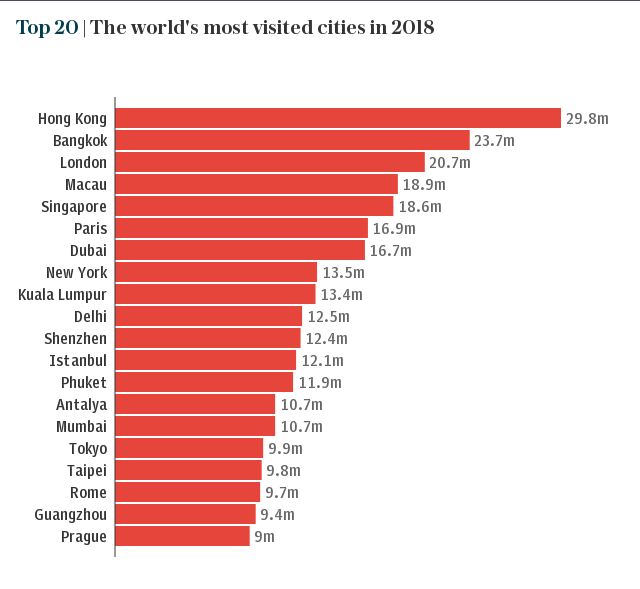Which is the world's most visited country?

The UN’s travel arm has released its latest figures detailing the movement of tourists around the world in 2018.
Last year, 1.4bn holidaymakers left home for an overseas break, 5.6 per cent more than in 2017, according to the World Tourism Organisation, which says that global travel is performing strongly “fuelled by a positive economy, increased air capacity and visa facilitation”.
But where were they all going?
France, of course. Our Gallic neighbours have sat atop the arrivals table as long as the UNWTO would care to remember, welcoming more than 93.2 million travellers last year, a 7.3 per cent increase on 2017 and the healthiest growth of the top 10 bar Thailand and Turkey.
The top five remained unchanged - France, Spain, the US, China and Italy - but it was Turkey that registered the greatest shift in fortunes at the business end of the rankings, rising two places to sixth after a 21.7 per cent increase in arrivals, to 45.8million.

The return of stability to the country and its resurgent tourism industry sees it leapfrog the UK, which fell from seventh to 10th, bumping both Germany and Thailand up the table.
Turkey is not alone in seeing a surge in the number of tourists.
“Montenegro recorded outstanding growth of 56 per cent in the first three months of 2019 as the country continues to promote its tourism potential,” the UNWTO said of the Balkan country, which saw 10.6 per cent growth in 2018, too, up to 2 million arrivals. “Other destinations such as Bosnia and Herzegovina and Israel also recorded double-digit growth as they portray themselves as attractive alternatives to more congested areas.”

Only last month did Telegraph Travel report on the latest luxury offering in the Mediterranean, a former Yugoslav military base on Montenegro’s Adriatic Coast.
But the largest growth seen anywhere in the world was in a country few Britons visit.
Landlocked in central Asia, Tajikistan saw its arrivals soar by 190 per cent from 2017 to 2018, from 431,000 to 1.2million. The Tajik government announced 2018 as a year of tourism development, but even they must be surprised at such instant success.
After a 2017 visit, writing for Telegraph Travel, Caroline Eden spoke of the beautiful isolation of the country.

Other destinations to record large growth included Egypt (36.8 per cent) and Tunisia (17.7 per cent), which are both recovering from terrorist incidents earlier in the decade and beginning to welcome more and more Britons back to their shores.
Ecuador, home to the Avenue of Volcanoes and a train journey called The Devil’s Nose, also experienced staggering growth, welcoming 51 per cent more tourists in 2018 than in 2017. The country seems to be reaping the rewards of a long-term plan to boost tourism through increased marketing, not least its biggest draw, the Galapagos.
Uganda, meanwhile, has risen in profile, marketing itself as the “Pearl of Africa” and seeing arrivals swell by 31.9 per cent.
Vietnam, too, saw decent growth (19.9 per cent), continuing the south-east Asian country’s meteoric rise.

Where are visitor number falling?
There were losers in 2018, as well as winners – including the UK. The first six months of the year saw a fall in arrivals of 6.8 per cent, while the third quarter saw another fall of 2.7 per cent. The UK has not confirmed its final numbers for 2018, but it has, provisionally, slipped down the table to 10th.
Paraguay saw its visitor numbers tumble 24.3 per cent, and Chile 11.3 per cent, while Venezuela’s figures have not been recorded; given the unrest there, a slump is certain.
Anguilla was hit by Hurricane Irma, so its 20 per cent fall in visitors is unsurprising. So too for St Maarten’s 55.8 per cent decline, and the British Virgin Islands’ 42.5 per cent loss.
And which was the most visited city?
Euromonitor International’s analysis shows Hong Kong leading the way with 29.8m arrivals forecast for 2018 (up seven per cent), followed by Bangkok (23.7m; up 5.5 per cent) and London (20.7m; up 4.5 per cent). The UK capital’s closest European rivals are Paris (sixth, with 16.9m visitors) and Istanbul (12th with 12.1m).

It appears Asian cities are climbing the table largely at the expense European ones.
Chennai (45th overall), cricket obsessed, and a surprising coffee capital; Agra (29th), home to the world’s most beautiful building; and thrilling but undeniably chaotic Delhi (13th), are projected growth of 30.4 per cent, 24.3 per cent and 23.1 per cent, respectively.
Conversely, Rome will fall three places in 2018 (to 18th), Venice will lose four positions (now 45th), and Florence two (now 49th). Berlin’s 2018 ranking is 36th (down two spots).
But Euromonitor also highlighted Porto’s surge up the rankings. It has advanced 42 places since 2012 to reach the top 100 for the first time this year.


